Tutorial 10: Frequency filters
Authors: Francois Tadel, Elizabeth Bock, John C Mosher, Sylvain Baillet
We are now going to process our continuous recordings to remove the main sources of noise. Typically, we can expect contaminations coming from the environment (power lines, stimulation equipment, building vibrations) and from the subject (movements, blinks, heartbeats, breathing, teeth clenching, muscle tension, metal in the mouth or the body). In this tutorial, we will focus first on the noise patterns that occur continuously, at specific frequencies.
We can correct for those artifacts using frequency filters. Usually we prefer to apply the frequency filters before any other type of correction, on the continuous recordings. They can be applied to the recordings without much supervision, but they may create important artifacts at the beginning and the end of the signals. Processing the entire continuous recordings at once instead of the imported epochs avoids adding those edge effects to all the trials.
Contents
Evaluation of the noise level
Before running any type of cleaning procedure on MEG/EEG recordings, we recommend to always start with a quick evaluation of the noise level. An easy way to do this is to estimate the power spectrum of all the sensors over the entire recordings.
- Clear the list of files in the Process1 tab.
Select all the three datasets we have linked to our protocol.
You can select the three "link to raw file" nodes, the three folders or the entire subject node.

- Click on [Run] to open the pipeline editor window.
Select the process "Frequency > Power spectrum density (Welch)"
This process evaluates the power of the MEG/EEG signals at different frequencies, using the Welch's method (see Wikipedia or MathWorks). It splits the signals in overlapping windows of a given length, calculates the Fourier Transform (FFT) of each of those short segments, and average the power of the FFT coefficients for all the overlapping windows.
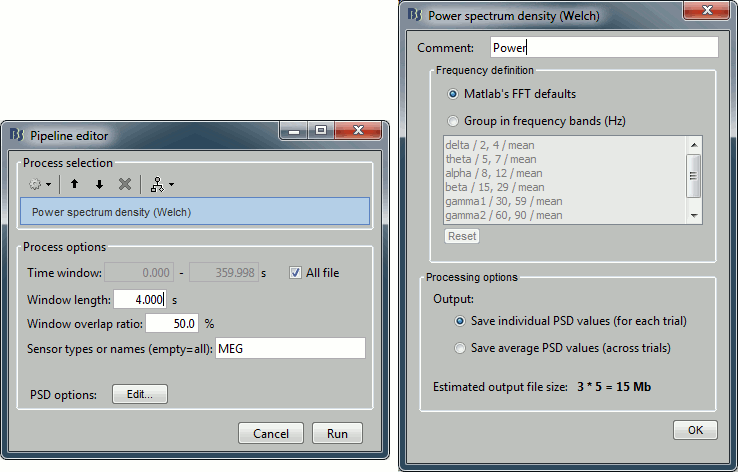
- Set the options as follows (click on [Edit] for the additional options):
Time window: [All file]
Portion of the input file you want to use the for estimating the spectrum.Window length: 4 seconds
Estimator length = length of the overlapping time windows for which we calculate the FFT. The number of time samples in the estimator is the same as the number of frequency bins in the output file. Increasing this parameter increases the output frequency resolution (distance between two frequency bins) but degrades the stability of the estimator, because we decrease the total number of averaged time windows.Overlap: 50%
How much overlap do we want between two consecutive two time windows.Sensor types or names: MEG
In some processes, you can specify the names or types of sensors on which you want to apply the process. This way you can for instance apply different filters on the EEG and the MEG, if you have both in the same files.Frequency definition: Matlab's FFT default
You have the option to use directly the frequency binning returned by the FFT, or do an additional step of averaging those bins in larger frequency bands. Note that you can edit those frequency bands.Output: Save individual PSD value.
This option will estimate separately the PSD for each of the three files in input, and create three files in output. If you select the other option (save average), it calculates the same three files but averages them on the fly and saves only one file in the database.
- Click on [Run] to start the execution of the process.
Troubleshooting: If you get "Out of memory" errors, try to run this PSD estimation on a shorter time segment. For example, set the time window to [0,100s] instead of the full file. This process starts by loading all the needed recordings in memory, you might not have enough memory available on your system to fit the entire dataset.
It produces three new files, that appear as "depending" on the three datasets we have linked. The comment of the files indicate how many overlapping windows could be used to estimate the PSD. "179/4000ms" means 179 windows of 4s each (total 716s). With the 50% overlap, it sums up to a little less than 2x the file length (360s).
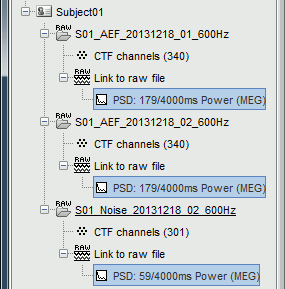
Interpretation of the PSD
File: AEF#01
Double-click on the new PSD file for run #01 to display it (or right-click > Power spectrum).
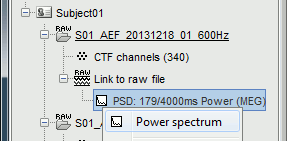
- The power spectrum is displayed in a figure similar to the time series, but the X axis represents the frequencies. Most of the shortcuts described for the recordings are also valid here. Clicking on the white parts of the figure or using the arrow keys of the keyboard move the frequency cursor. The current frequency can also be controlled with a new slider displayed in the Brainstorm window, just below the time panel.
Each black line represent the spectrum for one channel. If you click on a channel, it is selected and highlighted in red. Click again for deselecting. Right-click on a channel to read its name.
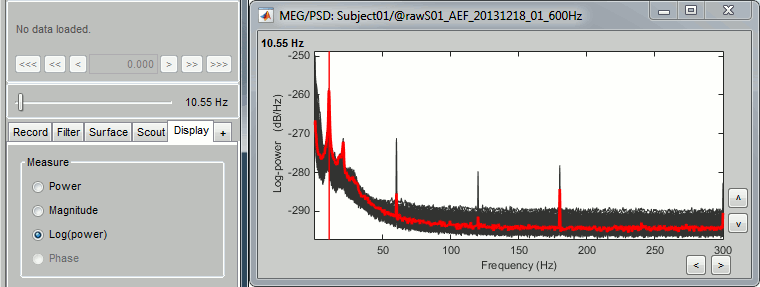
- The shape of this graph is normal, it does not indicate anything unexpected:
Peaks related with the subject's alpha rhythms: around 10Hz and 20Hz.
Peaks related with the power lines: 60Hz, 120Hz and 180Hz.
These datasets were recorded in Canada, where the alternative current is delivered at 60Hz. In Europe you would observe similar peaks at 50Hz, 100Hz and 150Hz.
- Add a topography view for the same file, with one of the two methods below:
Right-click on the PSD file > 2D Sensor cap.
Right-click on the spectrum figure > 2D Sensor cap (shortcut: Ctrl+T)
Scroll in frequencies to see the spatial distribution of each frequency bin:

- We have already identified two artifacts we will need to remove: the eye movements and the contamination from the power lines.
File: AEF#02
Open the spectrum view for the run AEF#02.
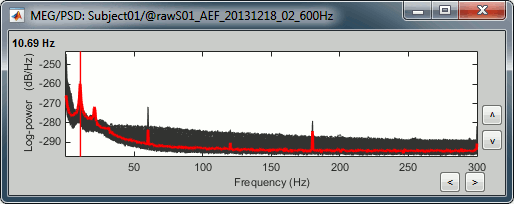
Add a 2D sensor cap view for the same file. Scroll to zoom in/out.
To display the sensor names, right-click on the figure > Channels > Display sensors.- This spectrum looks very similar to the run #01: same alpha and power line peaks.
Additionally, we observe higher level of noise in frequencies in the range of 30Hz to 100Hz on many occipital sensors. This is probably due to some tension in the neck muscles due to an uncomfortable position. We will see later whether those channels need to be tagged as bad.
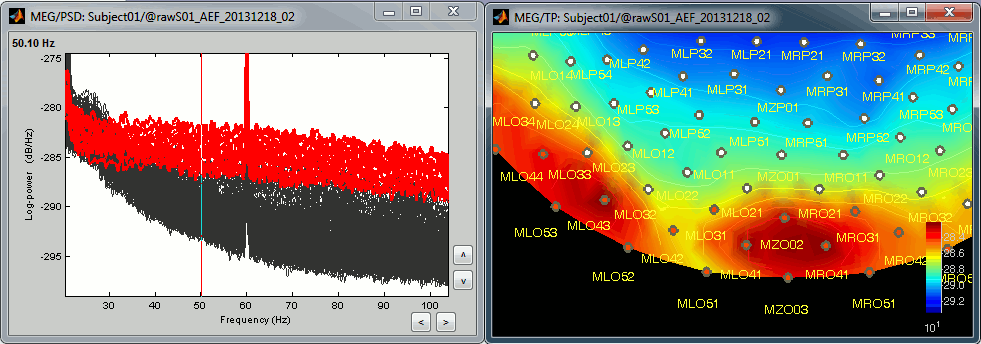
File: Noise recordings
Open the spectrum view for the noise recordings.
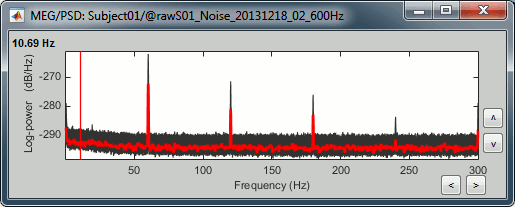
- This shows the power spectrum of the signals that are recorded when there is no subject in the MEG room. It gives a good and simple representation of the instrumental noise. If you had one bad MEG sensor, you would see it immediately in this graph. Here everything looks good.
Notch filter
Let's start with cleaning for the 60Hz due to the power lines and its harmonics. Notch filters are adapted for removing some well identified contaminations from systems oscillating at a very stable frequency.
Keep all the three datasets selected in the Process1 box.
All the filters that are applied to the experiment data also need to be applied to the noise recordings. In the source estimation process, we will need both to have similar levels of noise.- Click on [Run] to open the Pipeline editor.
Select the process: Pre-process > Notch filter
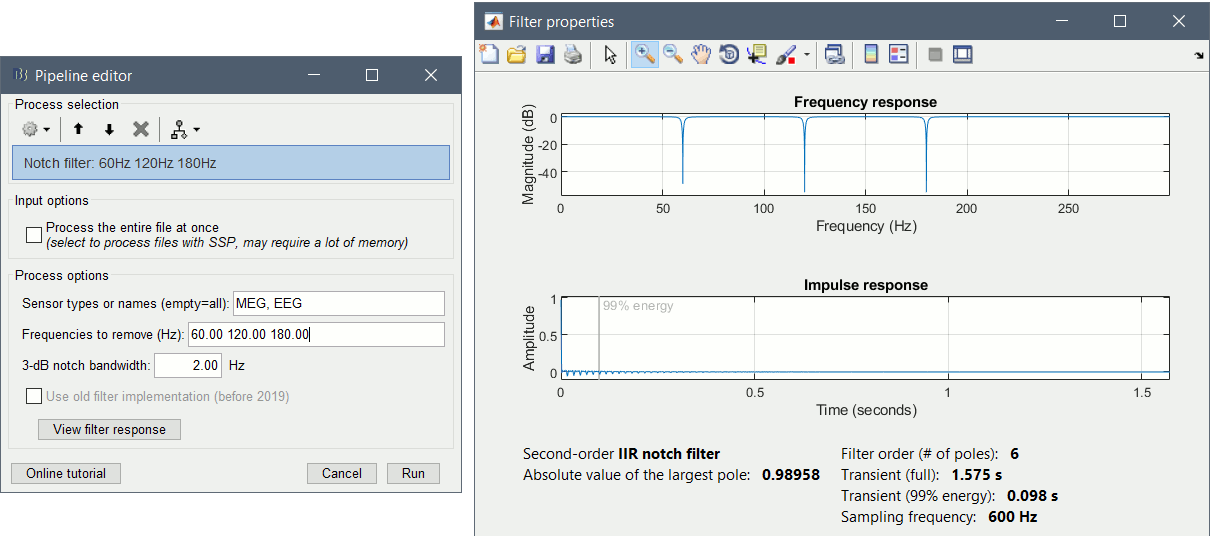
Process the entire file at once: NO
Select the frequencies: 60, 120, 180 Hz
Sensor types or names: MEG
- The higher harmonics (240Hz) are not clearly visible, and too high to bother us in this analysis.
In output, this process creates three new datasets, with additional "notch" tags. Those output files are saved directly in the Brainstorm database, in a binary format specific to Brainstorm (.bst).
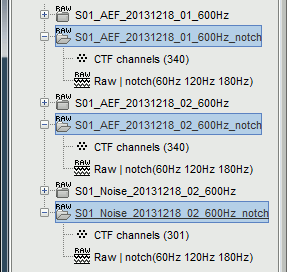
- If you delete the folders corresponding to the original files (before the filter), your original recordings in the .ds folders are not altered. If you delete the folders corresponding to the filtered files, you will lose your filtered recordings in .bst format.
To check where the file corresponding to a "Link to raw file" is actually saved on the hard drive, right-click on it > File > Show in file explorer.
Evaluation of the filter
Right-click on the Process1 list > Clear list.
Drag and drop in Process1 the three filtered files.
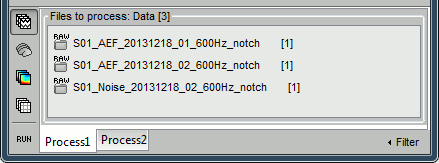
Run again the PSD process "Frequency > Power spectrum density (Welch)" on those new files, with the same parameters as before, to evaluate the quality of the correction.
Double-click on the new PSD files to open them.
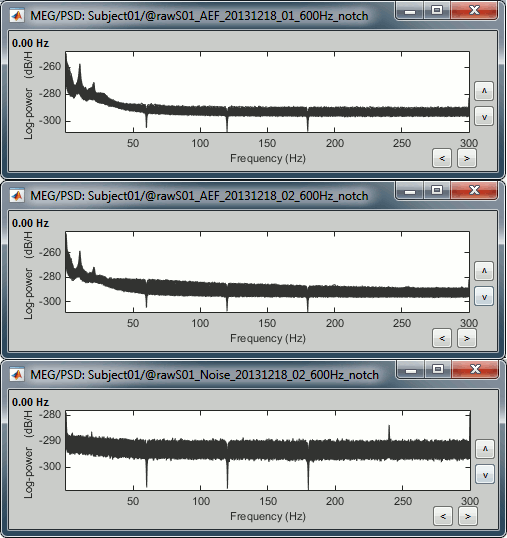
Scroll to zoom in to observe what is happening around 60Hz (before / after).
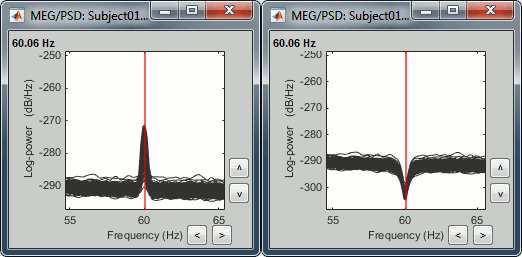
Some cleaning
To avoid the confusion later, delete the links to the original files:
Select the folders containing the original files and press Delete (or right-click > File > Delete).
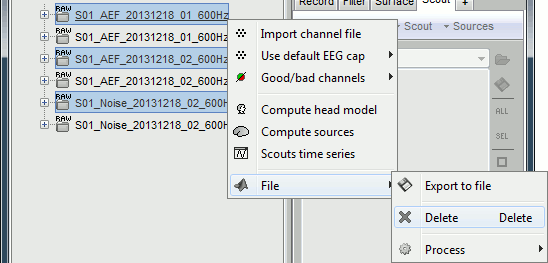
Always read the confirmation messages carefully, you will avoid some bad surprises.

This is what your database explorer should look like at the end of this tutorial:
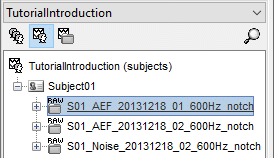
Alternatives to the notch
If the notch filter is not giving satisfying result, you can use two other processes.
Sinusoid removal: This process can do a better job at removing precise frequencies by identifying the sinusoidal components and then subtracting them from the signals in time domain (not a frequency filter).
Band-stop filter: This process can be useful for removing larger segments of the spectrum, in case the power line peaks are spread over numerous frequency bins or for suppressing other types of artifacts.
Other filters
Other frequency filters could be interesting to run at an early stage of analysis.
High-pass filter: Removes the low frequency from the signals. This could be used for:
Removing the slow fluctuations of the arbitrary baseline value of the MEG sensors (< 0.2Hz).
Removing the artifacts occurring at low frequencies (< 1Hz, for instance breathing).
Doing a baseline correction of the EEG/MEG recordings when there is no clear pre-stimulus baseline in the experiment or in the case of long epochs (> 5s).
Low-pass filter: Removes the high frequencies from the signals. This could be used for:
- Removing some strong noise occurring at high frequencies.
Facilitating the interpretation of the signals: if you are interested only in lower frequencies (for instance < 20Hz), everything in the higher part of the spectrum is noise in your analysis.
Both filters are accessible using the process Pre-process > Band-pass filter.
Important: Frequency filters and sinusoid removals are operations that you should apply at very early stages of the analysis, before epoching the recordings. Those operations do not perform well next to the beginning and the end of the signals, they may generate important artifacts. It is therefore much more accurate to filter the entire recordings from the original continuous file at once, rather than filtering small epochs after importing them in the database.